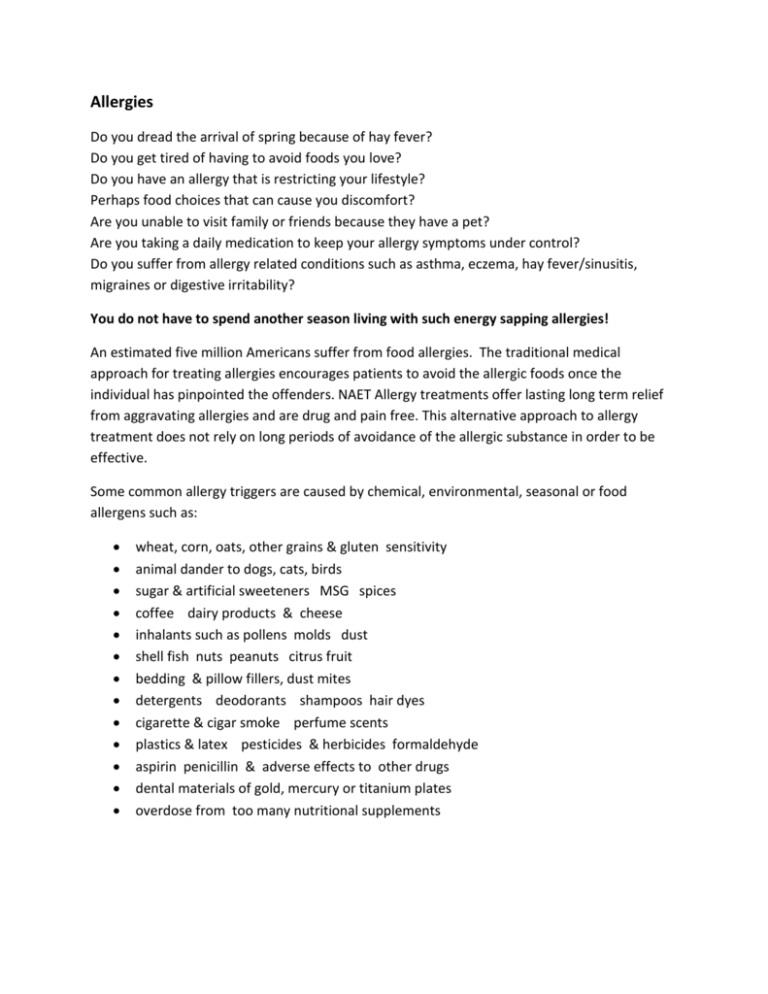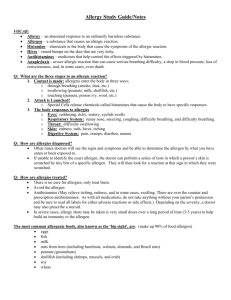3) What is an Allergy? - Allergy Natural Solutions Seattle
advertisement

Allergies Do you dread the arrival of spring because of hay fever? Do you get tired of having to avoid foods you love? Do you have an allergy that is restricting your lifestyle? Perhaps food choices that can cause you discomfort? Are you unable to visit family or friends because they have a pet? Are you taking a daily medication to keep your allergy symptoms under control? Do you suffer from allergy related conditions such as asthma, eczema, hay fever/sinusitis, migraines or digestive irritability? You do not have to spend another season living with such energy sapping allergies! An estimated five million Americans suffer from food allergies. The traditional medical approach for treating allergies encourages patients to avoid the allergic foods once the individual has pinpointed the offenders. NAET Allergy treatments offer lasting long term relief from aggravating allergies and are drug and pain free. This alternative approach to allergy treatment does not rely on long periods of avoidance of the allergic substance in order to be effective. Some common allergy triggers are caused by chemical, environmental, seasonal or food allergens such as: wheat, corn, oats, other grains & gluten sensitivity animal dander to dogs, cats, birds sugar & artificial sweeteners MSG spices coffee dairy products & cheese inhalants such as pollens molds dust shell fish nuts peanuts citrus fruit bedding & pillow fillers, dust mites detergents deodorants shampoos hair dyes cigarette & cigar smoke perfume scents plastics & latex pesticides & herbicides formaldehyde aspirin penicillin & adverse effects to other drugs dental materials of gold, mercury or titanium plates overdose from too many nutritional supplements What is an Allergy? Most of us become familiar with the word allergy as children, either because we ourselves had an allergic reaction such as hives or wheezing or have seen reactions in friends or family. Allergic illness arises from the body’s sensitivity to the mold, dust or pollen substances we are exposed to environmentally. Many of us do not realize that many uncomfortable physical, mental & emotional symptoms can be can be triggered by single or multiple food sensitivity. Why does the body react? The body reacts because the brain and immune programmed systems mistake things that are harmless for things full of danger. For instance, a harmless bit of mold, dust or ragweed pollen meanders by. For some odd reason, the nose reacts fearfully to this innocent pollen, triggering an escalation of uncomfortable symptoms: sneezing, dripping, itching and stuffing up, as if the pollen was intent on sharing a horrible infection. It is not! It is the nose that is mistaken. Unfortunately, the miserable person attached to the nose suffers. It is the same process with a food allergy. The miserable person, affected by this process, eats a little shrimp and disaster strikes. Their eyes water, their body swells and they choke up trying to get air as their air passages narrow. Many people associate allergies with sneezing, coughing, runny nose and itchy streaming eyes and in more intense cases anaphylactic shock. Often our perception of allergies is incorrect. It’s our brain that triggers an inappropriate response and the immune system that follows its commands. This is why allergic reactions generally have little to do with the properties of the substances that triggered them. Pollen, mold, animal dander or food does not directly cause any allergic response. They are triggering mechanisms, just like the trigger of a gun. The bullets they release are numerous natural body chemicals, like histamines. These chemicals flood the body, dilating blood vessels, leaking fluids and itching nerve fibers. They stuff the nose and eyes and hive the skin when we allergic people encounter certain pollens, shrimp and numerous other things that cause allergies. An allergic reaction may strike dramatically and quickly. The sneezing and swollen eyes after contact with ragweed and cat dander are obvious. The diagnosis is often confirmed by blood tests that measure antibodies, called IgE, which attach to ragweed or cat dander. The allergic basis of some illnesses is not so obvious. Food allergies frequently can have quick developing symptoms but they can also appear as a slow developing illness that are hard for allergy doctors to do their specialty diagnosis with. With quick acting food reactions, it can be the protein that the body becomes hyper alert to, a different protein than the person’s own body protein. For instance there are proteins in nuts, cow’s milk and shrimp that are different than the proteins making up the body’s organs or muscles. When the body recognizes this strange protein, it triggers the allergic illness of asthma, hives, hay fever etc. Often tiny amounts of these proteins lead to dangerous and sometimes life threatening reactions. Foreign proteins are not the only cause of food allergies. Some food chemicals that are not proteins and not foreign to the body are also involved; chemicals and nutrients that live in every cell of the body. It can be chemicals that are essential for metabolism and necessary for healthy cell physiology. For example, nutrients such as vitamin B or C, calcium or salt in the body can create a slow allergic reaction. The challenge is the individual with these chemical intolerances has no way of identifying the guilty foods. To unravel the mystery surrounding the treatment of the food allergy, the harm caused by deficiencies or excesses of these chemicals must be recognized. Traditional Medical Diagnosis and Treatment for Allergies Currently, conventional medicine has several methods for diagnosing allergies. They include: A blood panel workup using the ELIZA or RAST test The scratch test done on the skin. Interdermal testing Patch test Pulse testing Patch or Scratch Skin testing Although other methods of allergy testing are plentiful, traditional methods of testing has never been considered reliable. Western trained allergy doctors rely on skin testing (either the patch or scratch test). These topical skin tests have suspected allergies introduced into the body with an injection of the allergen. The site of the injections is observed for topical skin reactions. This method of testing is invasive, painful and time consuming. Some allergic patients can have extreme reactions to this testing, triggering anaphylactic shock to those with extreme sensitivity. This method is not that effective in identifying allergies to food. Interdermal testing This medical allergy test is considered to be more accurate for food allergies than the skin scratch test. A small extract of the allergen is injected Interdermal, into the surface layers of skin. Dr. Nambudripad, in her book “Goodbye to Illness” shares that, “Many people who show no reaction to the dermal or scratch type of test show positive results when the same allergies are applied interdermally.” The painful procedure can cause soreness for several days. The patient must wait a few days or weeks between tests, because only one set of allergens can be tested at a time. ELISA Blood Tests Elisa translates into Enyzme Linked immune-zorbent assay blood test. In this blood serum test, the blood is screened for immunoglobulins. Previous exposure to the allergens is necessary for this test to be positive. For this test to show some positive results, the individual must be exposed to a particular food within a specified period of time. If the person has never been exposed to specific and suspected allergic food, the test results will be unsatisfactory. The Pulse Test The simple pulse test was developed by an allergy doctor, Dr. Arthur Coca in the 1950’s. This is another simple method for determining food allergies. His early research showed that your pulse rate speeded up, if you ingested something that you were allergic to within 5 minutes of introducing it to the body. NAET Testing Patients being treated with the NAET method place a suspected allergen sample in a sterilized glass jar. To test reactions to the allergen, the individual needs to hold the sample in one hand for 15 to 30 minutes. Dr. Nambudripad has observed that an allergic person will begin to feel uneasy when holding the allergen in their palm for some time. The subtle energetics of the body will register the allergen in their energy field. With lengthened exposure times, unpleasant reactions such as itching, nausea, light headedness, a quickening or slowing down of the pulse are common. For additional information about food sensitivities, allergies and NAET treatment, you will want to talk with Kris directly. Call to make an appointment today 206.370.2600






